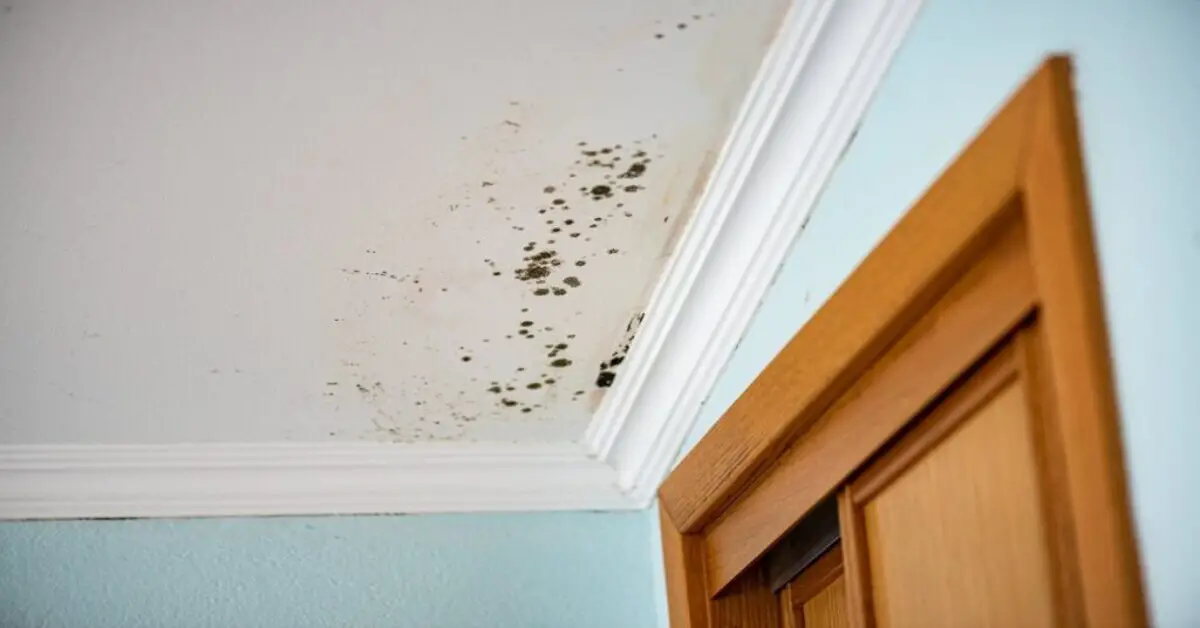
Dealing with mould on the ceiling can be a frustrating and unsightly problem for homeowners. Not only does it negatively impact the appearance of the ceiling, but it can also pose potential health risks.
Mould growth is often a result of excess moisture and poor ventilation, making it crucial to address the underlying causes to effectively eliminate the issue.
Identifying the Causes of Mould Growth
Mould growth on the ceiling is typically a result of excessive moisture accumulation. Several factors contribute to this issue, including:
-
Leaks and Water Intrusion
One common cause of mould growth on the ceiling is water leaks from the roof or plumbing system.
Even small leaks can lead to significant moisture buildup over time, creating an ideal environment for mould to thrive.
-
High Humidity Levels
In areas with high humidity, such as bathrooms or kitchens, condensation can occur on the ceiling surface.
When warm air comes into contact with a cool surface, like the ceiling, moisture droplets form, promoting mould growth.
-
Poor Ventilation
Inadequate ventilation prevents proper air circulation, trapping moisture and allowing mould to develop.
Rooms with insufficient ventilation, such as basements or poorly ventilated bathrooms, are particularly prone to mould problems.
Understanding the Health Risks Associated with Mould
Mould growth on the ceiling can have adverse effects on your health, especially for individuals with respiratory conditions or allergies.
Some common health risks associated with mould include:
-
Allergic Reactions
Exposure to mould spores can trigger allergic reactions in sensitive individuals. Symptoms may include sneezing, coughing, nasal congestion, itchy eyes, and skin rashes.
-
Respiratory Issues
Mould spores can cause respiratory problems, particularly in people with asthma or other respiratory conditions.
Inhaling these spores may lead to wheezing, chest tightness, shortness of breath, and even severe asthma attacks.
-
Fungal Infections
In some cases, prolonged exposure to certain types of mould can lead to fungal infections. These infections can affect the skin, nails, and respiratory system, causing further complications.
How to Get Rid of Mould on Ceiling?
1. Proper Ventilation
Ensure that rooms prone to excess moisture, such as bathrooms and kitchens, are adequately ventilated. Use extractor fans or open windows to allow fresh air to circulate and expel humid air.
2. Use Dehumidifiers
In areas with consistently high humidity, using dehumidifiers can help reduce moisture levels. Place them strategically to target specific areas prone to dampness.
3. Address Water Leaks Promptly
Inspect your roof, plumbing system, and any potential sources of water leaks regularly. Promptly repair any leaks to prevent water intrusion and subsequent mould growth.
4. Control Indoor Humidity
Keep indoor humidity levels below 60% to inhibit mould growth. Use air conditioners, ventilation systems, or moisture-absorbing products to maintain optimal humidity levels.
5. Proper Insulation
Properly insulate your home to regulate temperature differentials and prevent condensation. Insulate ceilings, walls, and floors to minimize moisture buildup.
6. Use Mould-Resistant Paint
Consider using mould-resistant paint on your ceiling. These paints contain additives that inhibit mould growth, providing an extra layer of protection.
7. Use Exhaust Fans
In rooms without windows or adequate ventilation, such as bathrooms, use exhaust fans to remove humid air.
Run the fans during and after activities that generate moisture, such as showering or cooking.
8. Wipe off Condensation
If condensation forms on the ceiling, wipe it off immediately using a dry cloth or paper towel. This helps prevent moisture from seeping into the ceiling material.
9. Maintain Proper Drainage
Ensure proper drainage around your property. Clean gutters and downspouts regularly to prevent water from pooling near the foundation and potentially seeping into the ceiling.
10. Regularly Inspect Crawl Spaces and Attics
If your home has crawl spaces or attics, regularly inspect them for signs of leaks or excess moisture. Properly ventilate these areas to prevent mould growth.
Natural Remedies for Removing Mould
When dealing with mould on the ceiling, many people prefer using natural remedies. These remedies are effective and environmentally friendly. Here are some natural methods you can try:
1. Vinegar Solution
Mix equal parts of white vinegar and water in a spray bottle. Spray the solution onto the mouldy areas and let it sit for an hour. Scrub the surface with a brush or sponge, then wipe clean with a damp cloth.
2. Baking Soda Paste
Create a paste by mixing baking soda with water. Apply the paste to the mouldy areas and scrub gently. Rinse the ceiling with water and wipe it dry.
3. Tea Tree Oil Spray
Add a teaspoon of tea tree oil to a cup of water and mix well. Pour the mixture into a spray bottle and mist it onto the mouldy areas. Leave it for a few hours before wiping clean.
4. Hydrogen Peroxide Solution
Mix equal parts of hydrogen peroxide and water in a spray bottle. Spray the solution onto the mouldy areas and let it sit for 10 minutes. Scrub the surface with a brush or sponge, then wipe clean.
5. Citrus Seed Extract
Dilute citrus seed extract according to the instructions on the product. Spray the diluted solution onto the mouldy areas and let it sit for a few hours. Scrub the surface and wipe clean.
6. Saltwater Solution
Mix a teaspoon of salt with a cup of water to create a saltwater solution. Spray the solution onto the mouldy areas and scrub gently. Rinse the ceiling with water and wipe it dry.
Using Cleaning Products to Eliminate Mould
For more stubborn mould infestations, using specialised cleaning products can provide effective results.
Here are some cleaning products commonly used to eliminate mould:
1. Chlorine Bleach
Mix one part chlorine bleach with three parts water. Apply the solution to the mouldy areas and let it sit for 15 minutes. Scrub the surface with a brush or sponge, then rinse thoroughly.
2. Anti-Mould Sprays
There are various anti-mould sprays available in the market. Follow the instructions provided on the product for effective use.
Spray the product onto the mouldy areas, let it sit for the recommended time, and wipe clean.
3. Mould and Mildew Removers
Mould and mildew removers are specifically formulated to tackle mould problems. Apply the product to the affected areas, following the instructions on the label. Scrub the surface and rinse thoroughly.
4. Peroxide-Based Cleaners
Peroxide-based cleaners can be effective in removing mould stains and killing mould spores. Apply the cleaner to the mouldy areas, let it sit for a designated time, and scrub the surface before rinsing.
5. Ammonia-Based Cleaners
Ammonia-based cleaners can be used to remove mould on non-porous surfaces. Ensure proper ventilation when using ammonia and follow the instructions on the product for safe and effective application.
When using cleaning products, always wear protective gloves, a mask, and ensure proper ventilation in the area. Follow the instructions on the product labels and take necessary precautions to safeguard your health.
6. Seeking Professional Help
In some cases, mould growth on the ceiling may be extensive, persistent, or require specialised treatment.
Seeking professional help is advisable to ensure thorough removal and prevent future recurrences.
Professional mould remediation services can provide:
1. Comprehensive Inspection
Qualified professionals will conduct a thorough inspection of the affected area to identify the extent of mould growth and determine the underlying causes.
2. Safe Mould Removal
Experienced technicians will employ industry-standard techniques and equipment to safely remove mould from the ceiling. They will follow proper containment and disposal protocols to prevent cross-contamination.


